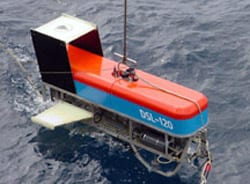DSL-120A Sonar
The DSL-120A is an underwater vehicle that is tethered to the ship by a long fiber optic cable. Scientists use the DSL to map underwater terrain. However, instead of using light to map the bottom, it uses sound. The DSL-120A is equipped with two side-scan sonars one that maps to the right, and one that maps to the left. Each sonar has one pinger that
sends sound waves to the ocean floor once every 0.8 seconds, and two receivers that catch the echoes. The sonars gather two types of information. First, they measure the intensity of the returning signal. Just as a tennis ball bounces higher off of a driveway than off of the soft grass, the sound waves bounce harder off of hard surfaces than soft surfaces. Second, the sonar measures the bathymetry or contours of the surface it is mapping. Here is where the two receivers come into play. When the pinger bounces a signal off of a flat area, the echo should reach the two receivers at the exact same time. If, however, the pinger bounces the signal off of a slope, the echo returns at a different angle and reaches one of the receivers before the other. The time interval between when the echo reaches the first receiver and the second receiver is called the
phase shift. The length of the phase shift depends on the slope.
Note: the DSL-120A vehicle was successfully transitioned from NDSF/ WHOI to the
Hawaii Mapping Research Group (HMRG) in May 2007.
See Also
Hawaii Mapping Research Group (HMRG)
Processing and mapping for the WHOI DSL-120A deep towed 120 kHz mapping system.

